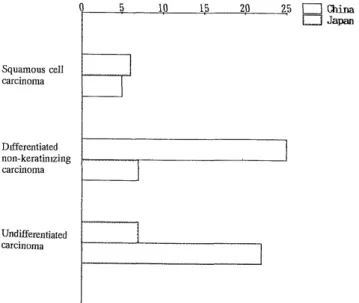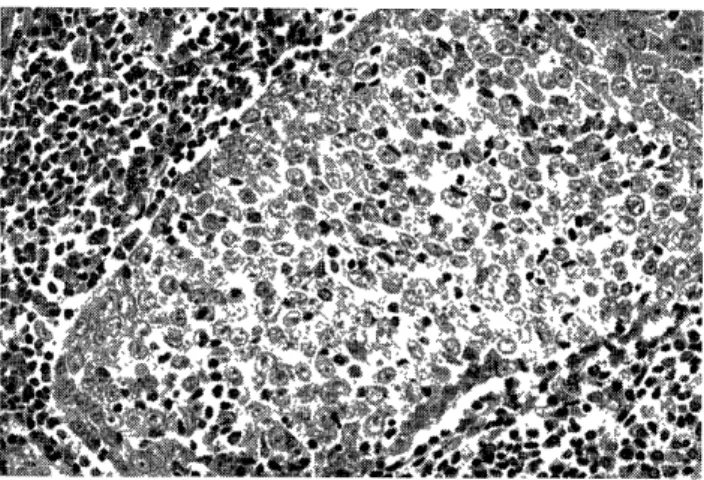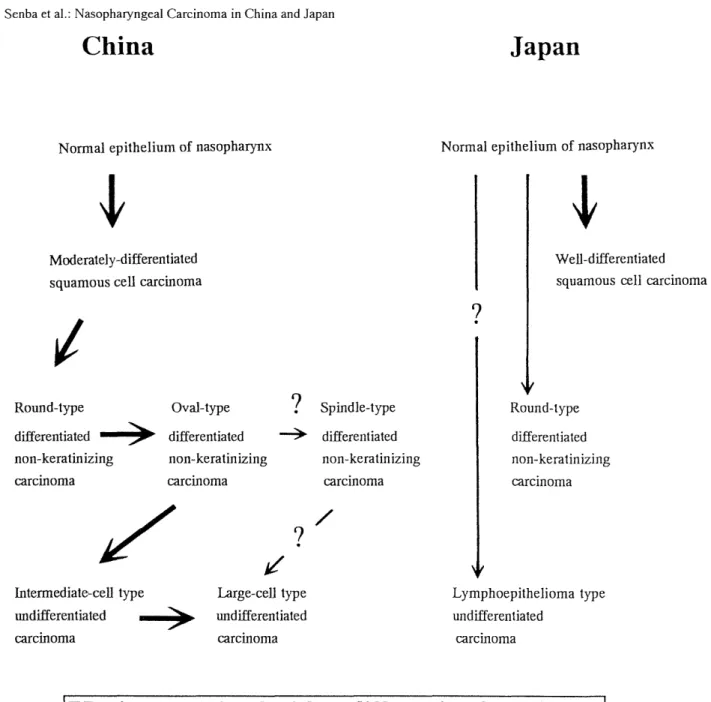Acta Med. Nagasaki 38:242 - 246
Histopathological Difference of Nasopharyngeal Carcinoma in Southern China and Japan
Masachika Senba, Xue-Yun Zhong and Hideyo Itakura
Department of Pathology, Institute of Tropical Medicine, Nagasaki University, 1-12-4 Sakamoto, Nagasaki 852 Japan
Histopathological analysis was carried out to examine the character- istics of nasopharyngeal carcinoma (NPC) using 38 biopsy cases obtained from southern China and 34 cases obtained from Japan.
These cases were divided into three groups according to their predominant pattern associated with the cell and the tissue differen- tiation using the World Health Organization (WHO) histological classification of tumors as follows: (i) squamous cell carcinoma; 6 Chinese cases and 5 Japanese cases, (ii) differentiated non- keratinizing carcinoma; 25 Chinese cases and 7 Japanese cases, (iii) undifferentiated carcinoma; 7 Chinese cases and 22 Japanese cases.
The age of Chinese patients ranged from 21 to 80 years with a mean of 46 years and Japanese patients ranged from 17 to 89 years with a mean of 53.8 years. The male to female ratio was 2.7:1.0 in China and 1.8:1.0 in Japan. The most common histological type of NPC in China was differentiated non-keratinizing carcinoma, however, it was undifferentiated carcinoma in Japan. The mechanism of cancer arising from the nasopharynx may be quite different between Chinese and Japanese cases. The Chinese NPC cases were considered as continuity shift from normal epithelium to differentiated non- keratinizing carcinoma, to undifferentiated carcinoma sequence. On the other hand, the Japanese cases were considered discontinuity shift.
Therefore, in Chinese cases, NPC formation mechanism may be that EBV infection and chemical carcinogens can act synergistically in the enhancement of both viral replication and malignant transformation.
It is suggested that some Japanese cases are associated with Epstein- Barr virus infection, although, mechanism of formation of NPC in Japanese cases is not yet clear.
Introduction
Nasopharyngeal carcinoma (NPC) was first reported as a neoplasm occurring in the nasopharynx, characteristic by anaplastic cells surrounded by prominent infiltration of lymphoid cells, this tumor has been designated as "lym- phoepithelioma" or NPC. The nucleus features of the carcinoma cells are distinctive with large nucleus and prominent nucleolus. The cytoplasmic features of the carci- noma cells are variable and the cellular borders are often indistinct due to fusion of cytoplasms. NPC has been
Correspondence to: Dr. Masachika Senba, Department of Pathology, Institute of Tropical Medicine, Nagasaki University, 1-12-4 Sakamoto, Nagasaki 852, Japan
confirmed as a tumor arising from squamous epithelium by electron microscopical and immunohistochemical exami- nation. According to the World Health Organization (WHO) histological classification, NPC was divided into three types; squamous cell carcinoma, differentiated non- keratinizing carcinoma, and undifferentiated carcinoma."' The Epstein-Barr virus (EBV) is associated with a variety of benign and malignant lymphoproliferative diseases, most notably infectious mononucleosis, Burkitt's lymphoma, and NPC. The presence of EBV has been reported in undiffer- entiated NPC, and partially differentiated non-keratinizing NPC, but not in squamous cell NPC. Lymphoepithelioma of the nasopharynx has been shown by electronmi- croscopical and immunohistochemical studies to be an anaplastic variant of squamous cell carcinoma. There is many evidences supporting the strong association beween EBV and nasopharyngeal lymphoepithelioma and NPC.
Lymphoepitheliomas occur outside of the nasopharynx, although they are rare. Histologically similar undiffer- entiated carcinoma associated with marked lymphoid cell infiltration is called lymphoepithelioma-like carcinoma which have been found in the tonsil,"' salivary gland,',") thymus,") uterine cervix," skin,") lung," and stomach.")
In this report, we described histopathological character- istics of NPC in China and Japan using 38 caese of Chinses patients and 34 cases of Japanese patients. This investi- gation was undertaken as an extention of our previous work. '3, 14,21)
Materials and Methods
The NPC specimens from 38 biopsy cases at the Jinan University Hospital in southern China and 34 biopsy cases at the Nagasaki University Hospital in Japan were used in this study. Shanmugaratnam and Sobin criteria were applied in assigning the diagnosis of NPC to the tissue.
These NPC cases were divided into three groups; (i) squa- mous cell carcinoma type, (ii) differentiated non- keratinizing carcinoma type, and (iii) undifferentiated car- cinoma type.
The specimens were fixed in 10% formalin, and em-
bedded in paraffin for histopathological study. Sections were cut at 4 micron and stained with hematoxylin- and-eosin for histological examination.
Results
The Chinese patients ranged in age from 21 to 80 years with a mean of 46 years. The male to female ratio was 2.7:1.0 in China. The Japanese patients ranged in age from 17 to 89 years with a mean of 53.8 years. The male to female ratio was 1.8:1.0 in Japan. Fig. 1 shows age distri- bution of NPC in China and Japan. The highest incidence of NPC in China was found in the 41-50-year-old age group, and NPC in Japan was detected with highest inci- dence in the 61-70-year-old age group. In China, no case
was found in the 11-20-year-old and 81-90-year-old age groups. The sex distribution revealed that males had higher rates than females in China as well as in Japan. As shown in Fig. 2, the incidence of squamous cell carcinoma in the Japanese cases was similar to the incidence of Chinese cases. The most common histological type of NPC in China was differentiated non-keratinizing carcinoma. On the oth- er hand, NPC in Japan was undifferentiated carcinoma was higher than in China. These findings showed different incidence of histological classification of NPC in different geographic groups. Histologically, squamous cell carci- noma was quite different between China and Japan, be- cause most of the Chinese cases were moderately differentiated squamous cell carcinoma (Fig. 3), but most of the Japanese cases were well differentiated squamous cell carcinoma (Fig. 4). Differentiated non-keratinizing
Fig. 1. Age distribution of nasopharyngeal carcinoma in China and Japan.
Fig. 2. Distribution histological classification of nasopharyngeal carcinoma in China and Japan.
Fig. 3. China case: Squamous cell carcinoma type of nasopha- ryngeal carcinoma with abundant lymphoid cell infiltrate. Hema- toxylin and eosin stain, X 200.
Fig. 4. Japan case: Squamous cell carcinoma type of nasopha- ryngeal carcinoma with numerous lymphoid cell infiltrate. Hema- toxylin and eosin stain, X 200.
carcinoma type was similar in China and Japan (Figs. S and 6). Most of the undifferentiated carcinoma in China showed pleomorphism in the cytoplasms type (Fig. 7). On the other hand, most of the undifferentiated carcinoma in Japan showed the lymphoepithelioma type (Fig. 8). Sum- mary of histogenesis of NPC in China and Japan is shown in Fig. 9. Chinese cases had continuity shift, on the other hand, Japanese cases has shown discontinuity shift. Be- cause, in Chinese cases, coexistence of squamous cell carcinoma and differentiated non-keratinizing carcinoma were seen in the same tumor tissue, and also coexistence of differentiated non-keratinizing carcinoma and undiffer- entiated carcinoma were demonstrated in the same neo- plastic tissue. However, such phenomena were not detected in the same cancerous tissues in Japanese cases.
Fig. 5. China case: Differentiated non-keratinizing carcinoma type of nasopharyngeal carcinoma with heavy lymphoid cell infiltrate. Hematoxylin and eosin stain, X 200.
Fig. 6. Japan case: Differentiated non-keratinizing carcinoma type of nasopharyngeal carcinoma with abundant lymphoid cell infiltrate Hematoxylin and eosin stain, X 200.
Fig. 7. China case: Undifferentiated carcinoma (non-lympho- epithelioma) type of nasopharyngeal carcinoma with numerous lymphoid cell infiltrate. Hematoxylin and eosin stain, X 200.
Fig. 8. Japan case: Undifferentiated carcinoma (lymphoepi- thelioma) type of nasopharyngeal carcinoma with heavy lymphoid cell infiltrate. Hematoxylin and eosin stain, X 200.
Fig. 9. Histogenesis of nasopharyngeal carcinoma in China and Japan. The authors conclude that Chinese cases are continuity shift, on the other hand, Japanese cases are discontinuity shift.
Discussion
Thirty-eight cases of NPC collected from southern China and 34 cases of NPC collected from Japan were examined.
Malignant neoplasms primarily arising from the nasopha- rynx are most commonly carcinoma or malignant lym- phoma. Undifferentiated NPC is accompanied by prominent lymphocytic infiltration. Therefore, it is often difficult to differentiate from malignant lymphomas, espe- cially of the large-cell type. The typical histological appear- ance is undifferentiated carcinoma with infiltration of
lymphoid cells that may be so prominent as to suggest a malignant lymphoma. Immunohistochemical techniques have been proven useful in the diagnosis of nasopharyngeal lymphoepithelioma and NPC. NPC is a definite malignant epithelial neoplasm and can be distinguished from malig- nant lymphoma by immunohistochemical staining for kera- tin, epithelial membrane antigen (EMA), and carcinoembryonic antigen (CEA).Z'' Specifically, keratin is the most reliable epithelial marker for identifying NPC and excluding malignant lymphoma."' In general, nasopha- ryngeal lymphomas have been studied under the category
of Waldeyer's ring lymphoma or nasal lymphoma. Many researchers reported that most of Waldeyer's ring lym- phoma cases were B-cell phenotype. On the other hand,
most of nasal lymphoma cases were T-cell phenotype.',"
The incidence of malignant lymphoma per 100,000 popula- tion was 11-32 in Japan, and 0.1-0.9 in China. Therefore, malignant lymphoma in nasopharynx is more frequent in Japan than in China. In the nasopharynx, a component of Waldeyer's ring has abundant lymphoid tissues, and naso-
pharyngeal lymphoma is more frequent in Japan than in China.
Epstein-Barr virus (EBV), a human herpesvirus, is strongly linked with two forms of B-cell lymphoma and with a much more prevalent epithelial malignancy, undif- ferentiated NPC and partially differentiated non- keratinizing NPC.4 10.20' EBV has been closely associated with the undifferentiated NPC, which is particularly com-
mon in the high risk area in southern China. However, EBV normally infects pharyngeal epithelial cells and is often found in the salivary gland tissue. Thus, the presence of EBV positive tumors in the nasopharynx and salivary gland is not surprising. Current methods for detection of EBV are as follows: southern blot analysis, DNA ampli- cation in situ hybridization with either isotopic probes or nonisotopic probes, and immunohistochemistry with anti- latent membrane protein (LMP), terminal protein (TP or LPM2), and six nuclear antigens (EBNAs 1, 2, 3a, 3b, 3c, EBNA-leader protein). As to NPC formation in southern China three interacting factors considered: (1) abnormal HLA profiles, (ii) infection of EBV, and (iii) traditional Cantonese diets, especially salted fish.'' The carcinogens in salted fish and other traditional Cantonese diet are still unknown and a systematic search for such substances is necessary. NPC arises commonly among Asian people but is quite rare in other parts of the world. It is suggested that undifferentiated NPC due to EBV infection may be asso- ciated with geographical and/or ethnic origin. On the other
hand, in America, Chinese immigrants in the second and third generation seem to have lower risk of NPC than first generation Chinese." A possible explanation may be that EBV infections and environmental chemicals could act synergistically in the carcinogenic process." This hypoth- esis is supported by epidemiological and experimental evidences that viral replication and virally induced trans- formation were dramatically enhanced by chemical carcin- ogens. Therefore, chemical carcinogens could activate nasopharyngeal epithelial cells to EBV infection, or already carrying EBV, resulting in development of NPC.
References
1) Burt RD, Vaughan TL, McKnight B: Descriptive epidemiology and survial analysis of nasopharyngeal carcinoma in the United States. Int
J. Cancer; 52:549-556, 1992.
2) Butler AE, Colby TV, Weiss LM, Lombard C: Lymphoepithelioma-
like carcinoma of the lung. Am. J. Surg. Pathol., 13:632-639, 1989.
3) Chan JKC, Ng CS, Lau WH, Lo STH: Most nasal/nasopharyngeal
lymphomas are peripheral T-cell neoplasms. Am. J. Surg. Pathol., 11:418-429, 1987.
4) Dawson CW, Rickinson AB, Young LS: Epstein-Barr virus latent membrane protein inhibits human epithelial cell differentiation. Na-
ture, 344:777-780, 1990.
5) Ferry JA, Sklar J, Zukerberg LR, Harris NL: Nasal lymphoma: A clinicopathologic study with immunophenotypic and genotypic anal-
ysis. Am. J. Surg. Pathol., 15:268-279-, 1991.
6) Ho JHC, Huahg DP, Fong YY: Salted fish and nasopharyngeal
carcinoma in southern Chinese. Lancet, ii:626, 1978.
7) Krishnamurth S, Lanier AP, Dohan P, Lanier JF, Henle W: Salivary gland cancer in Alaskan natives, 1996-1980. Hum. Pathol.,
18:986-996, 1987.
8) Mills SE, Austin MB, Randall ME: Lymphoepithelioma-like carci- noma of the uterin cervix: a distinctive, undifferentiated carcinoma
with inflammatory stroma. Am. J. Surg. Pathol., 9:883-889, 1985.
9) Niedobitek G, Young LS, Sam CK, Brooks L, Prasad U, Rickinson AB: Expression of Epstein-Barr virus genes and of lymphocyte acti-
vation molecules in undifferentiated nasopharyngeal carcinoma. Am.
J. Pathol., 140:879-887, 1992.
10) Parshall DB, Stenstrom KW: Malignant lesions of the tonsil. Radi- ology, 60:564-571, 1953.
11) Saw D, Lau WH, Ho JHC, Chan JKC, Ng CS: Malignant lymphoe- pithelial lesion of the salivary gland. Hum. Pathol., 7:914-923, 1986.
12) Senba M, Zhong XY: Immunohistochemical investigation of nasopha- ryngeal carcinoma using keratin, EMA, laminin, fibronectin, collagen
type IV, laminin receptor, and laminin/collagen receptor antibodies.
Acta Med Nagasaki., 38: (in press), 1993.
13) Senba M, Zhong XY: T-cell rich B-cell cross-reacting nasopharyngeal
carcinoma. Acta Med Nagasaki., 38: (in press), 1993.
14) Senba M, Zhong XY: Proliferating cell nuclear antigen (PCNA), nuclear organizer resions (AgNORs), and mitotic indeces in nasopha-
ryngeal carcinoma. Acta Med Nagasaki., 38: (in press),1993.
15) Shanmugaratnam K, Sobin LH: Histological typing of upper respi- ratory tract and ear: WHO international histological classification of
tumors. 2nd Ed. Berlin, Springer-Verlag, 1991.
16) Shi SR, Goodman ML, Bhan AK, Pilch BZ, Sun TT: Immunohis-
tochemical study of nasopharyngeal carcinoma using monoclonal keratin antibodies. Am. J. Pathol., 117:53-63, 1984.
17) Shibata D, Tokunaga M, Uemura Y, Sato E, Tanaka S, Weiss LM:
Association of Epstein-Barr virus with undifferentiated gastric carci-
nomas with intense lymphoid infiltration: Lymphoepithelioma-like
carcinoma. Am. J. Pathol., 139:469-474, 1991.
18) Swanson SA, Cooper PH, Mills SE, Wick MR: Lymphoepithelioma-
like carcinoma of the skin. Mod. Pathol., 1:359-365, 1988.
19) Wick MR, Scheithauer BW, weiland LH, Bernatz PE: Primary thymic carcinomas. Am. J. Surg. Pathol., 6:613-630, 1985.
20) Zhang HY, Tao K, Shu HC, Glaser R: Expression of the Epstein-Barr
virus genome in nasopharyngeal carcinoma epithelial tumor cell line.
Int. J. Cancer, 46:944-946, 1990.
21) Zhong XY, Senba M, Gu JN, Itakura H: B-cell antigen marker expression on the nasopharyngeal carcinoma. Zentralbl. Pathol., (in
press), 1993.


